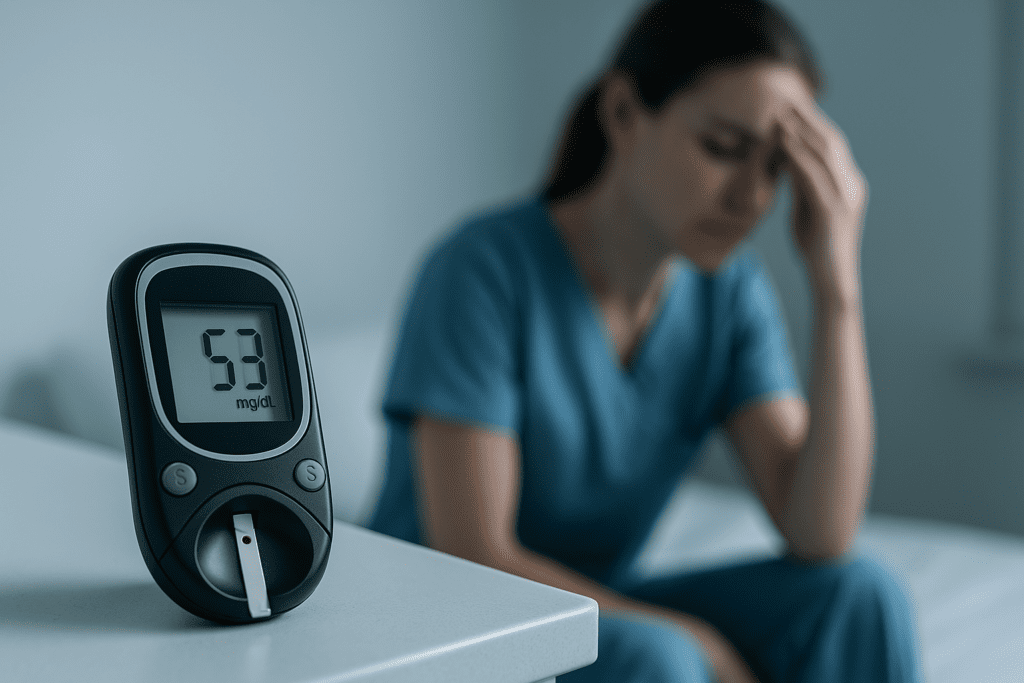Understanding the Link Between Dizziness and Type 1 Diabetes
For individuals living with type 1 diabetes, dizziness can be a familiar, and at times unsettling, sensation. While it may seem alarming, feeling dizzy is often a normal physiological response to fluctuations in blood sugar levels. In particular, low blood sugar—also known as hypoglycemia—is a common culprit. This condition arises when blood glucose drops below the normal range, disrupting the brain’s ability to function optimally since glucose is its primary energy source. As a result, symptoms like lightheadedness, shakiness, and even blurred vision can emerge.
You may also like: Breakthroughs in Current Diabetes Research: What the Latest Studies Reveal About Treatment and Prevention
Recognizing that it is normal to feel dizzy with type 1 diabetes, especially during episodes of low blood sugar, is the first step toward managing the condition more confidently. Understanding the underlying mechanisms helps remove the fear associated with these episodes and reinforces the importance of proactive glucose monitoring. While dizziness should never be ignored, acknowledging its role as a common sign of blood sugar dysregulation empowers patients and caregivers alike to respond quickly and appropriately.
The experience of dizziness varies from person to person and can be influenced by multiple factors such as medication timing, physical activity, food intake, and even stress. Therefore, having a nuanced understanding of how and why dizziness arises is critical for both prevention and management. Medical experts emphasize that early recognition of hypoglycemia symptoms is essential for preventing more severe complications like confusion, loss of consciousness, or seizures.
As medical research continues to advance, new insights into the relationship between dizziness and blood sugar instability are emerging. These discoveries are deepening our understanding of type 1 diabetes and enhancing strategies for effective blood glucose control. With this knowledge, healthcare providers and patients can better tailor interventions and lifestyle adjustments to improve safety and quality of life.
What Happens During Low Blood Sugar Episodes?
Low blood sugar occurs when the body has too little glucose circulating in the bloodstream. In people with type 1 diabetes, this typically results from an imbalance between insulin levels and glucose intake. When too much insulin is administered or physical activity outpaces the body’s glucose supply, blood sugar can fall rapidly. This drop in glucose deprives cells, particularly those in the brain, of their primary energy source, leading to symptoms that include dizziness, sweating, and difficulty concentrating.
Feeling dizzy during a hypoglycemic event is not only common but also one of the earliest warning signs that blood sugar levels are out of balance. This is why individuals with type 1 diabetes must learn to recognize and interpret bodily cues. Dizziness may begin subtly, such as a sense of imbalance or fogginess, and can escalate quickly if untreated. The sensation may be accompanied by other symptoms such as trembling, hunger, irritability, or heart palpitations.
From a physiological standpoint, hypoglycemia activates the body’s sympathetic nervous system—also known as the “fight or flight” response. This leads to the release of hormones like adrenaline, which attempt to restore glucose levels by triggering glycogen breakdown in the liver. However, if these efforts are not enough or if the individual fails to consume glucose promptly, symptoms can intensify. Understanding this cascade of events underscores the importance of early intervention.
Research has shown that repeated low blood sugar episodes can blunt the body’s natural warning signals, a condition known as hypoglycemia unawareness. For patients experiencing frequent dizziness due to low blood sugar, this presents a unique challenge, as the absence of symptoms may delay treatment. Addressing this issue often requires comprehensive glucose monitoring, dietary adjustments, and a strategic review of insulin dosing schedules.
Medical professionals stress that while it is normal to feel dizzy with type 1 diabetes under these circumstances, frequent or severe episodes should not be ignored. Persistent dizziness can interfere with daily activities, impair cognitive performance, and increase the risk of injury from falls or accidents. Therefore, recognizing and managing low blood sugar effectively is an essential part of diabetes care.

Why Dizziness Should Be Taken Seriously, Even When It’s Common
Though dizziness in type 1 diabetes is often a benign and expected symptom of low blood sugar, it warrants serious attention due to its implications. For one, dizziness can compromise situational awareness and reaction time, which is especially dangerous while driving, operating machinery, or engaging in physical activity. Studies have indicated that even mild hypoglycemia can significantly impair motor skills and judgment, making timely recognition and correction of symptoms critical.
Another reason to take dizziness seriously is that it can signal the beginning of a more severe hypoglycemic episode. If untreated, these episodes can progress to neuroglycopenia, a condition in which the brain is deprived of sufficient glucose. This can lead to slurred speech, visual disturbances, confusion, seizures, or loss of consciousness. Understanding the trajectory from dizziness to more dangerous manifestations of low blood sugar emphasizes the need for prompt action.
Furthermore, frequent hypoglycemia episodes can alter the brain’s response to glucose deficiency over time. In people who repeatedly experience dizziness from low blood sugar, the brain may adapt in ways that reduce the warning symptoms, increasing the risk for severe hypoglycemia without awareness. This makes regular monitoring and education even more vital, as patients may no longer rely solely on physical sensations to detect low blood sugar.
Healthcare professionals recommend that individuals who often feel dizzy due to low blood sugar should work closely with their care teams to adjust treatment plans. This may involve changing insulin dosages, revising carbohydrate intake strategies, or using continuous glucose monitors (CGMs) that can alert users to impending lows. Personalized care plans that address the frequency and context of dizziness can dramatically reduce its occurrence and enhance safety.
Lastly, it is important to distinguish dizziness caused by hypoglycemia from other possible causes, such as dehydration, medication side effects, or cardiovascular issues. While type 1 diabetes is the most likely source in many cases, medical evaluation can help rule out other conditions and ensure comprehensive treatment. This holistic approach aligns with best practices in diabetes management and emphasizes the importance of addressing even common symptoms with due diligence.
The Science Behind Why It’s Normal to Feel Dizzy with Type 1 Diabetes
From a scientific perspective, the relationship between low blood sugar and dizziness is well-established. Glucose is the brain’s exclusive fuel under normal physiological conditions, and any significant drop in glucose levels disrupts neuronal function. As a result, the brain’s processing speed slows, sensory perception becomes impaired, and symptoms like dizziness or vertigo may emerge. This is not only expected but entirely normal within the context of hypoglycemia.
Recent studies have explored the neurological consequences of type 1 diabetes low blood sugar episodes, particularly their impact on brain structure and cognitive function over time. Research published in journals such as Diabetes Care and The Lancet Diabetes & Endocrinology indicates that recurrent hypoglycemia can lead to subtle changes in brain regions responsible for memory, attention, and coordination. These changes reinforce the need to understand dizziness not as a trivial inconvenience but as a window into deeper physiological processes.
Moreover, the role of insulin and its timing is critical. Insulin therapy is essential in type 1 diabetes, but when dosed incorrectly or taken without adequate food intake, it can rapidly lower blood sugar levels. The balance between insulin and carbohydrate intake must be carefully calibrated to prevent sharp declines in glucose. For example, taking a rapid-acting insulin before a delayed meal or following unexpected physical activity can result in sudden dizziness due to plummeting glucose levels.
Interestingly, individual variations in glucose thresholds can affect when and how dizziness occurs. Some people may feel dizzy when blood sugar dips slightly below 80 mg/dL, while others might not notice symptoms until levels are below 60 mg/dL. These thresholds can shift over time and in response to metabolic changes, medications, and lifestyle factors. Understanding this variability helps patients recognize their personal patterns and refine their management strategies accordingly.
Ultimately, the normalization of dizziness in type 1 diabetes stems from its predictable occurrence during low blood sugar episodes. While not all patients experience it the same way, the symptom remains a clinically recognized indicator that the body is alerting the brain to an energy deficit. Viewing dizziness through this lens helps demystify its presence and underscores its role as a crucial feedback mechanism in glucose management.

How to Prevent and Manage Dizziness in Type 1 Diabetes
Prevention is the cornerstone of managing dizziness related to type 1 diabetes. The most effective approach begins with consistent blood glucose monitoring and pattern recognition. By identifying trends in blood sugar fluctuations, individuals can anticipate when lows are most likely to occur and adjust their behavior accordingly. For example, recognizing that a particular type of exercise often leads to post-activity lows allows for preemptive carbohydrate intake or insulin adjustments.
Utilizing modern diabetes technology can significantly reduce the frequency and severity of dizziness episodes. Continuous glucose monitors (CGMs) provide real-time data and trend analysis, often accompanied by alerts that warn users of impending lows. These tools empower individuals to intervene before symptoms develop, offering an added layer of safety and control. Studies have shown that CGM use reduces the time spent in hypoglycemic ranges and improves overall glucose stability.
Dietary strategies also play a crucial role in prevention. Eating regular meals that include a balance of complex carbohydrates, proteins, and healthy fats helps maintain steady glucose levels. For those prone to late-day dizziness, incorporating small, frequent snacks or adjusting meal timing can prevent sudden drops. Additionally, understanding the glycemic index of foods allows individuals to choose options that provide a more gradual release of glucose into the bloodstream.
In situations where dizziness occurs despite preventative efforts, prompt intervention is essential. Consuming 15 to 20 grams of fast-acting carbohydrates—such as glucose tablets, fruit juice, or regular soda—can quickly raise blood sugar and alleviate symptoms. Following up with a more substantial snack helps sustain glucose levels and prevent recurrence. For those with frequent or severe episodes, keeping emergency glucose sources readily accessible is a vital safety practice.
Beyond physical measures, education and self-awareness are fundamental. Diabetes education programs can teach individuals how to interpret their body’s cues, adjust treatment regimens, and respond effectively to hypoglycemia. Partnering with endocrinologists, certified diabetes educators, and registered dietitians ensures that care plans are comprehensive and evidence-based. With these resources, individuals can confidently navigate the challenges of type 1 diabetes low blood sugar and minimize its impact on daily life.
Living Safely and Confidently with Type 1 Diabetes and Dizziness
Managing the relationship between type 1 diabetes and dizziness requires not only clinical strategies but also emotional resilience and lifestyle adaptation. For many individuals, the unpredictability of hypoglycemia and the disorienting nature of dizziness can lead to anxiety, particularly in public or high-stakes situations. Addressing the psychological aspects of this experience is just as important as managing the physiological symptoms.
One way to build confidence is by cultivating routines that support consistent blood glucose levels. This might include setting reminders for meals and insulin doses, carrying glucose sources at all times, and maintaining a diary of symptoms and interventions. These practices provide structure and reduce uncertainty, which can significantly enhance peace of mind. Moreover, discussing experiences with others who have type 1 diabetes can provide valuable insights and support.
It’s also helpful to educate family members, coworkers, and friends about what to do if a hypoglycemic event occurs. Knowing that others can recognize and respond to symptoms like dizziness, confusion, or fainting creates a safety net. Training others to use emergency tools like glucagon pens or to call for medical assistance when needed fosters a sense of community and preparedness.
In professional and academic settings, accommodations may be necessary to account for the unpredictability of blood sugar fluctuations. Whether it’s the ability to test blood sugar during class or take a break to eat during long meetings, these adjustments help individuals manage their condition without stigma or disruption. Advocating for such accommodations is an empowering step that reinforces both autonomy and health.
Ultimately, living well with type 1 diabetes and the occasional experience of dizziness is entirely achievable. With the right tools, education, and support systems in place, individuals can navigate these challenges effectively. Recognizing that dizziness is often a normal consequence of blood sugar changes—and learning to respond swiftly and wisely—transforms what could be a source of fear into an opportunity for greater self-mastery and health.

Frequently Asked Questions: Dizziness and Low Blood Sugar in Type 1 Diabetes
1. Can stress or anxiety make it more likely to feel dizzy with type 1 diabetes?
Yes, emotional stress and anxiety can influence blood glucose regulation, especially in people with type 1 diabetes. During stressful moments, the body releases hormones like cortisol and adrenaline, which can interfere with insulin sensitivity or cause delayed glucose fluctuations. This can lead to unpredictable blood sugar levels that may suddenly drop, causing symptoms like dizziness. While it is type 1 diabetes normal to feel dizzy during low blood sugar episodes, stress-related changes can make those episodes more erratic or harder to predict. Practicing mindfulness, cognitive behavioral therapy, or stress-reducing routines may help mitigate these effects and stabilize glucose levels.
2. Are there any medications besides insulin that could worsen dizziness in type 1 diabetes?
Yes, several non-diabetic medications can exacerbate dizziness in individuals with type 1 diabetes, particularly those that influence blood pressure, brain function, or hydration. For example, beta-blockers can blunt the symptoms of hypoglycemia, making it harder to detect low blood sugar until dizziness becomes severe. Diuretics, often prescribed for hypertension, may lead to dehydration, compounding the sense of lightheadedness. Additionally, sedatives or antipsychotic drugs may mask the brain’s ability to respond appropriately to glucose deficits. While it’s type 1 diabetes normal to feel dizzy in the context of low blood sugar, other medications can increase both the frequency and severity of such symptoms.
3. How can sleep patterns affect the risk of dizziness with type 1 diabetes?
Sleep disruption or irregular sleep-wake cycles can significantly influence blood sugar control. Inadequate sleep impairs insulin sensitivity, which in turn can lead to greater glycemic variability throughout the day. Some individuals may also experience nighttime hypoglycemia, which goes unnoticed until morning symptoms such as grogginess or dizziness arise. Since it’s type 1 diabetes normal to feel dizzy after a night of undetected low blood sugar, poor sleep hygiene can amplify the risk. Using continuous glucose monitors with nighttime alarms and maintaining consistent sleep habits may reduce these occurrences.
4. Is dizziness from low blood sugar in type 1 diabetes different from dizziness caused by dehydration?
While both types of dizziness may feel similar, they arise from different physiological mechanisms. Dizziness from type 1 diabetes low blood sugar stems from an energy shortage in the brain, while dehydration-related dizziness usually involves low blood volume and reduced blood pressure. The distinguishing factor often lies in the accompanying symptoms: hypoglycemia may present with shakiness, confusion, or rapid heartbeat, whereas dehydration often causes dry mouth, thirst, and dark urine. Because it is type 1 diabetes normal to feel dizzy during a hypoglycemic episode, understanding your hydration status and context can help differentiate the causes.
5. Can diet quality affect how frequently someone with type 1 diabetes experiences dizziness?
Absolutely. The macronutrient composition of meals influences how steadily glucose is released into the bloodstream. Diets that rely heavily on refined carbohydrates and sugary snacks tend to cause rapid glucose spikes followed by crashes, making low blood sugar and subsequent dizziness more common. Conversely, meals balanced with protein, fiber, and complex carbohydrates help smooth out glucose fluctuations and reduce hypoglycemic episodes. While it’s type 1 diabetes normal to feel dizzy in certain situations, optimizing meal structure can significantly lower the frequency and intensity of that experience.
6. Are people who frequently exercise more prone to dizziness with type 1 diabetes?
Exercise enhances insulin sensitivity and glucose utilization, which can increase the risk of hypoglycemia during or after physical activity. This is particularly relevant for individuals who engage in prolonged or high-intensity workouts. Without appropriate pre-exercise planning, such as adjusting insulin doses or consuming carbohydrates, a sudden drop in blood sugar can trigger dizziness. Although it’s type 1 diabetes normal to feel dizzy when blood sugar is low, frequent exercisers may encounter this symptom more often if they don’t adjust their routines strategically. Wearing CGMs and having fast-acting carbs on hand are practical safeguards.
7. Can environmental factors, like heat or altitude, make dizziness worse in type 1 diabetes?
Yes, extreme temperatures and high altitudes can amplify the effects of low blood sugar in people with type 1 diabetes. Heat can dilate blood vessels and increase insulin absorption, hastening glucose depletion and increasing the risk of hypoglycemia. At high altitudes, reduced oxygen levels and exertion can interfere with metabolic balance, leading to dizziness even at normal glucose levels. In either case, since it’s type 1 diabetes normal to feel dizzy with low blood sugar, these conditions can make the experience more intense or unpredictable. Being aware of environmental stressors and adjusting insulin or food intake accordingly is crucial.
8. What role does alcohol play in dizziness episodes for people with type 1 diabetes?
Alcohol can significantly increase the risk of delayed hypoglycemia, particularly during the night or several hours after consumption. It inhibits gluconeogenesis in the liver, impairing the body’s ability to recover from a blood sugar drop. This effect can be especially dangerous if symptoms are masked by intoxication. Therefore, it’s not uncommon for individuals to experience dizziness after drinking, even if they initially felt fine. While it’s type 1 diabetes normal to feel dizzy when low blood sugar occurs, alcohol complicates the situation by blunting warning signs and delaying corrective responses.
9. Could frequent dizziness indicate a long-term complication rather than just low blood sugar?
In some cases, yes. While it is type 1 diabetes normal to feel dizzy during hypoglycemic episodes, recurring dizziness may also suggest autonomic neuropathy, a complication where the nerves regulating involuntary bodily functions are damaged. This condition can lead to orthostatic hypotension—a drop in blood pressure upon standing—which causes dizziness independent of blood sugar levels. A thorough medical evaluation is essential to distinguish between acute low blood sugar and chronic underlying causes. Addressing neuropathy early can prevent further complications and improve quality of life.
10. What emerging technologies or treatments are helping reduce dizziness linked to low blood sugar?
New developments in diabetes care are making it easier to predict and prevent hypoglycemia-related dizziness. Hybrid closed-loop insulin pumps, often called artificial pancreas systems, use real-time glucose data to adjust insulin delivery automatically, helping to stabilize glucose and reduce low-blood-sugar episodes. Additionally, predictive algorithms in continuous glucose monitors can alert users to trends before symptoms occur. While it’s type 1 diabetes normal to feel dizzy with rapid glucose drops, these technologies are shifting the landscape by offering earlier interventions. Future innovations may include non-invasive glucose monitoring and improved insulin analogs with faster responsiveness and fewer side effects.
Recognizing Dizziness as a Normal Signal in Type 1 Diabetes: Final Thoughts
Feeling dizzy with type 1 diabetes is a common and often expected response to low blood sugar. While it should never be ignored, this symptom typically serves as an early warning sign rather than a medical emergency. Understanding why dizziness occurs—and how it relates to type 1 diabetes low blood sugar—can help individuals respond swiftly and effectively, preventing more severe complications. With advances in medical technology, personalized care, and better public awareness, patients can more easily identify and manage hypoglycemia before it interferes with their well-being.
By viewing dizziness not as a failure of control but as a meaningful physiological cue, people living with type 1 diabetes can feel more empowered and less anxious. Regular monitoring, strategic eating, timely insulin management, and open communication with healthcare providers all contribute to safer, more confident living. As new research continues to reveal the intricacies of how blood sugar affects brain function, our understanding of symptoms like dizziness will only deepen, enhancing care and improving outcomes for the millions of individuals affected by type 1 diabetes around the world.
diabetic dizziness management, signs of hypoglycemia, managing blood sugar levels, dizziness and insulin therapy, neurological effects of diabetes, hypoglycemia in daily life, diabetic glucose monitoring, diabetes-related fatigue, blood sugar imbalance symptoms, cognitive effects of low glucose, wearable tech for diabetes, understanding glucose fluctuations, diabetic safety tips, endocrinology and brain health, type 1 diabetes care strategies, hypoglycemia early warning signs, managing diabetes complications, exercise and blood sugar control, living with type 1 diabetes, dizziness in chronic illness
Further Reading:
Your guide to understanding Hypoglycemia (low blood sugar)
Hypoglycemia (Low Blood Sugar)
Can High Blood Sugar Cause Dizziness?
Disclaimer
The information contained in this article is provided for general informational purposes only and is not intended to serve as medical, legal, or professional advice. While MedNewsPedia strives to present accurate, up-to-date, and reliable content, no warranty or guarantee, expressed or implied, is made regarding the completeness, accuracy, or adequacy of the information provided. Readers are strongly advised to seek the guidance of a qualified healthcare provider or other relevant professionals before acting on any information contained in this article. MedNewsPedia, its authors, editors, and contributors expressly disclaim any liability for any damages, losses, or consequences arising directly or indirectly from the use, interpretation, or reliance on any information presented herein. The views and opinions expressed in this article are those of the author(s) and do not necessarily reflect the official policies or positions of MedNewsPedia.


